The Ultimate Comfort Food Fusion
The first time I witnessed a room full of dinner guests fall silent upon tasting this casserole, I knew I’d stumbled onto something magical. There’s somthing almost hypnotic about the combination of tender chicken chunks nestled among creamy potato layers, all embraced by melted cheese and punctuated with crispy bacon bits. This isn’t just dinner—it’s an edible hug that transforms any ordinary meal into a memorable gathering.

This casserole brilliantly marries two beloved comfort foods: loaded baked potatoes and chicken casserole. What makes it special is the thoughtful layering technique that ensures every bite delivers the perfect balance of flavors and textures. It’s hearty enough to be a complete meal yet versatile enough to complement almost any occasion, from casual family dinners to potluck showstoppers.
Ingredients & Substitutions
For the Base:
- 2½ pounds russet potatoes (about 6 medium), scrubbed clean
- 2 tablespoons olive oil
- 1 teaspoon kosher salt
- ½ teaspoon freshly ground black pepper
- 1 teaspoon garlic powder
- 1 teaspoon paprika
For the Filling:
- 1½ pounds boneless, skinless chicken breasts, cut into ¾-inch cubes
- 8 slices bacon, cooked crisp and crumbled
- 2 cups sharp cheddar cheese, freshly grated (pre-shredded works but won’t melt as beautifully)
- 3 green onions, thinly sliced (white and green parts separated)
- 1½ cups sour cream (full-fat provides the best texture)
- ¼ cup unsalted butter, melted
- ½ teaspoon garlic powder
- Salt and pepper to taste
Optional Toppings:
- Extra ½ cup cheddar cheese for topping
- 2 tablespoons chopped fresh parsley
- Additional sour cream for serving
- Hot sauce to taste
Russets are ideal here because there starchy nature creates that classic fluffy interior, but Yukon Golds offer a more buttery flavor if you prefer. For dairy-free versions, coconut yogurt mixed with a bit of lemon juice provides a surprisingly good sour cream alternative, while plant-based cheeses have improved dramatically in melting properties (look for ones with tapioca starch).
Chicken thighs can replace breasts for more succulent results, though they’ll need an extra 5-7 minutes cooking time. Turkey bacon works beautifully for those avoiding pork, while tempeh bacon can satisfy vegetarian guests when paired with plant-based chicken alternatives.
Step-by-Step Instructions
Preparing the Potatoes:
- Preheat your oven to 400°F (205°C) and line a large baking sheet with parchment paper for easy cleanup. Cut the potatoes into ¾-inch cubes, keeping the skin on for added texture and nutrition—this seemingly minor detail actually contributes significant flavor to the final dish.
- In a large bowl, toss the potato cubes with olive oil, salt, pepper, garlic powder, and paprika until evenly coated. Don’t rush this step; the even distribution of seasonings is crucial for consistent flavor throughout the casserole. Spread the potatoes in a single layer on the prepared baking sheet, giving them room to breathe.
- Roast for about 30-35 minutes, turning halfway through, until the edges are getting crispy and the centers are tender when pierced with a fork. The partial roasting before assembly prevents the dreaded mushy potato syndrome that plagues many casseroles. Let them cool slightly before assembly.
Preparing the Chicken:
- While the potatoes roast, season chicken cubes with salt and pepper. Heat a tablespoon of oil in a large skillet over medium-high heat until shimmering. Working in batches (overcrowding is the enemy of proper browning), cook the chicken until just golden on the outside and nearly cooked through, about 5-6 minutes per batch.
- Transfer the chicken to a paper towel-lined plate to remove excess oil. The chicken will finish cooking in the casserole, so slight undercooking at this stage actuelly prevents the meat from becoming dry in the final dish.
Creating the Cream Mixture:
- In a medium bowl, combine the sour cream, melted butter, garlic powder, half the crumbled bacon, the white parts of the green onions, and ½ cup of the cheddar cheese. Season with salt and pepper to taste, remembering that the bacon and cheese already contribute saltiness.
Assembly and Baking:
- Reduce oven temperature to 375°F (190°C). Lightly grease a 9×13-inch baking dish with butter or cooking spray. Layer half of the roasted potatoes in the bottom of the dish, creating an even base.
- Distribute half of the chicken pieces evenly over the potatoes, then spread half of the cream mixture on top. This layering technique ensures that flavors meld throughout rather than separating during baking. Sprinkle with ½ cup of the remaining cheese.
- Repeat with remaining potatoes, chicken, cream mixture, and another ½ cup of cheese. Top with the remaining bacon crumbles and the optional extra cheese if using. The final layer of cheese forms that irresistible golden crust that defines a great casserole.
- Bake uncovered for 25-30 minutes, until the cheese is bubbly and beginning to brown at the edges. For an extra-golden top, place under the broiler for the final 2 minutes, watching carefully to prevent burning.
- Allow the casserole to rest for 10 minutes before serving—this resting period is non-negotiable as it allows the layers to set and flavors to deepen. Garnish with the green parts of the onions and optional chopped parsley before serving.
Cooking Techniques & Science
The multi-stage cooking approach used here—roasting potatoes separately before combining them into the casserole—isn’t just about convenience. It’s a deliberate technique that leverages the Maillard reaction (that beautiful browning that creates complex flavors) while preventing the potatoes from becoming waterlogged during the final bake.
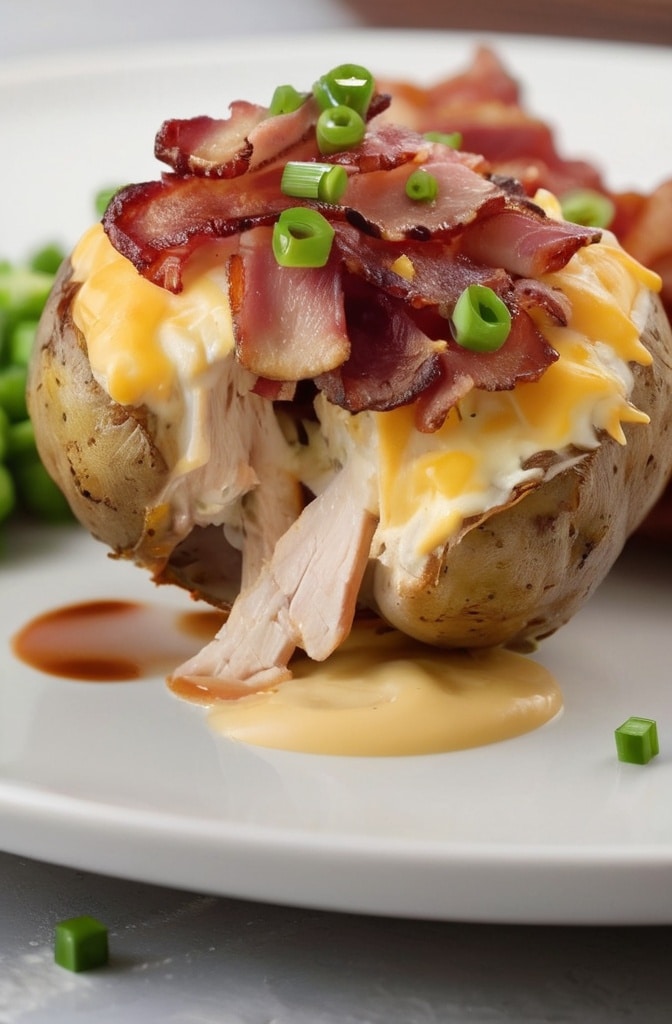
Pre-cooking the chicken achieves a similar result, creating flavor compounds through searing that wouldn’t develop in the moist environment of the casserole. The protein strands in the chicken breast also tighten less dramatically when they’re gradually brought up to temperature rather than subjected to the full heat of the oven from a raw state.
The layering technique isn’t merely aesthetic—it serves a crucial function in distributing moisture evenly throughout the dish. The sour cream mixture, which might seem excessive at first glance, actually creates pockets of creaminess that melt into the surrounding ingredients during baking, preventing any dryness in the chicken or potatoes.
A cast-iron skillet can replace the baking dish for enhanced heat retention and a rustic presentation. The consistent heat distribution of cast iron creates particularly crispy edges—those coveted corner pieces everyone fights over. If using cast iron, preheat it briefly in the oven before adding your first layer to jump-start the bottom crust formation.
Make-Ahead and Storage Options
This casserole shines in its make-ahead potential. You can prepare all components separately up to two days ahead, storing them in airtight containers in the refrigerator. Assemble just before baking, adding an extra 10-15 minutes to the baking time if the components are cold from the refrigerator.
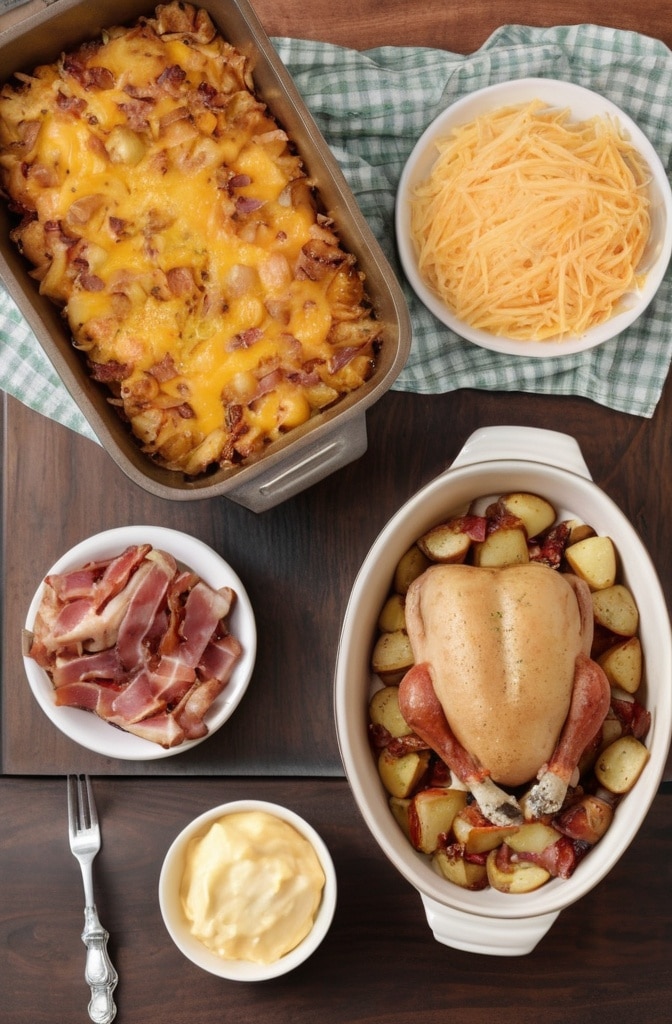
The fully assembled but unbaked casserole can be refrigerated for up to 24 hours. Simply cover tightly with plastic wrap, then aluminum foil. Remove from the refrigerator 30 minutes before baking to take the chill off.
Freezing works surprisingly well for this dish, though the texture of the potatoes does change slightly. To freeze, assemble in a freezer-to-oven safe container, cover tightly, and freeze for up to 2 months. Thaw overnight in the refrigerator before baking, or bake from frozen by reducing the oven temperature to 350°F and extending the cooking time by about 50%.
Leftovers maintain their quality for 3-4 days when properly refrigerated. Reheat individual portions in the microwave for 2-3 minutes or until heated through. For crisper results, use a 350°F oven for about 15 minutes—the extra time is worth it to revive those textural contrasts.
Serving & Pairing Suggestions
This casserole deserves thoughtful presentation despite its homey nature. Serve it in wide, shallow bowls that showcase the layers and provide enough surface area for the optional extra toppings. A drizzle of hot sauce creates not just a flavor pop but a visual contrast against the creamy background.
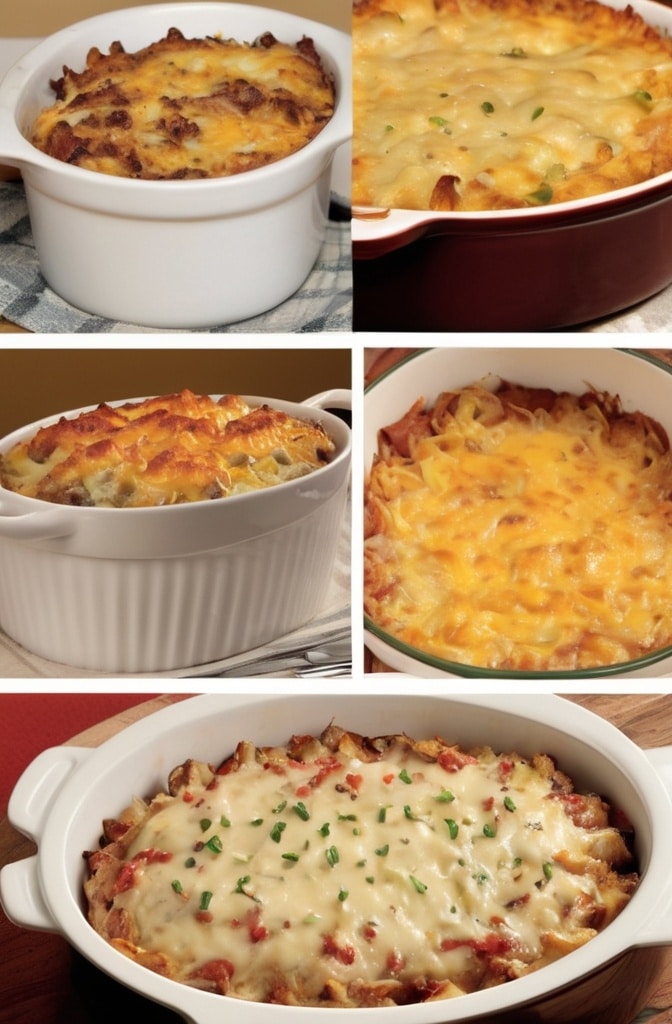
For family-style service, provide a selection of additional toppings in small bowls—extra sour cream, pickled jalapeños, diced avocado, or even crumbled cotija cheese—allowing guests to customize their portions.
Wine pairing might seem pretentious for casserole, but a buttery Chardonnay or crisp Pinot Grigio beautifully counterbalances the richness. Beer enthusiasts will find that a cold amber ale or wheat beer complements rather than competes with the dish’s complex flavors.
Round out the meal with a simple arugula salad dressed with lemon and olive oil. The peppery greens and bright acidity cut through the casserole’s richness, creating a balanced plate. For a heartier spread, roasted Brussels sprouts with balsamic glaze offer textural and flavor contrast.
Variations to Explore
The basic template of this casserole invites creative customization. For a Tex-Mex variation, incorporate a layer of black beans, swap the cheddar for a pepper jack blend, and add a diced poblano pepper to the potato mixture before roasting. Finish with crushed tortilla chips on top for unexpected crunch.
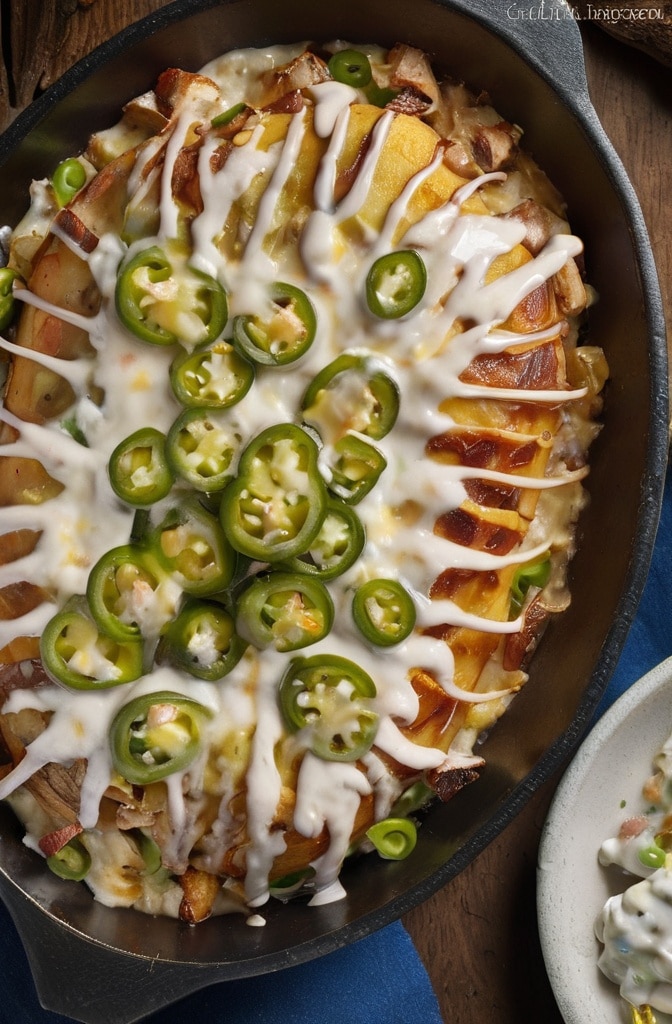
An Italian-inspired version might feature sun-dried tomatoes, basil, and mozzarella instead of cheddar, with Italian herbs seasoning the potatoes. Prosciutto can replace the bacon for a more delicate salty note.
For special diet considerations, the casserole adapts beautifully to gluten-free needs (it’s naturally gluten-free). Lowering carbs is trickier but can be approached by replacing half the potatoes with cauliflower florets, which roast beautifully alongside the potato chunks.
Family-friendly adaptations might include a milder cheese blend and minimal green onions for those with younger palates, while heat-seekers can incorporate diced jalapeños or a sprinkle of cayenne into the cream mixture.
Conclusion
The beauty of this Loaded Baked Potato and Chicken Casserole lies not just in its crowd-pleasing flavor profile but in its thoughtful construction. Each component contributes something essential: the roasted potatoes provide hearty substance, the chicken delivers satisfying protein, and the creamy element binds everything together into cohesive bites punctuated by bacon’s smoky crunch.
What elevates this from basic comfort food to something special is attention to technical details—proper potato cutting for even cooking, careful pre-searing of the chicken, and strategic layering that ensures consistent flavor distribution. These aren’t fussy cheffy flourishes but practical steps that transform good ingredients into something memorable.
Whether you’re cooking for a family weeknight dinner or contributing to a potluck gathering, this casserole offers that rare combination of impressive results with manageable effort. And isn’t that the ultimate goal of great home cooking? Dishes that nurture both body and spirit without exhausting the cook in the process.
Frequently Asked Question?
Can I make this casserole vegetarian?
A. Absolutely! Replace the chicken with roasted chickpeas (tossed with the same seasonings and roasted until crispy) or hearty mushrooms like portobello chunks. Use plant-based bacon and cheese substitutes, being careful to select varieties that melt well for that crucial gooey texture.
Why did my potatoes turn out mushy instead of maintaining their shape?
A. This typically happens when the potato pieces are cut unevenly, leading to inconsistent cooking, or when waxy potatoes are substituted for russets. Ensure your potato cubes are uniformly sized, and don’t skip the initial roasting step, which helps set their structure before they enter the moist environment of the casserole.
Can I use rotisserie chicken to save time?
A. Yes! Pre-cooked rotisserie chicken is a fantastic shortcut. Simply shred or cube about 3 cups of meat, and add it at the assembly stage without the pre-searing step. The smoky flavor of rotisserie chicken actually adds an extra dimension to the dish, though you may want to reduce the added salt slightly.
How can I make this casserole creamier/saucier?
A. For an ultra-creamy version, increase the sour cream to 2 cups and add ¼ cup of chicken broth to the cream mixture. You might also incorporate 4 ounces of softened cream cheese. Just be aware that a saucier version will need slightly longer to set up after baking—extend the resting time to 15 minutes before serving.
What’s the best way to reheat this without drying out the chicken?
A. Individual portions reheat beautifully in the microwave covered with a damp paper towel, which creates steam to rehydrate the components. For whole leftovers, cover the casserole dish with foil and heat at 325°F until warmed through (about 20 minutes), removing the foil for the final 5 minutes to re-crisp the top.
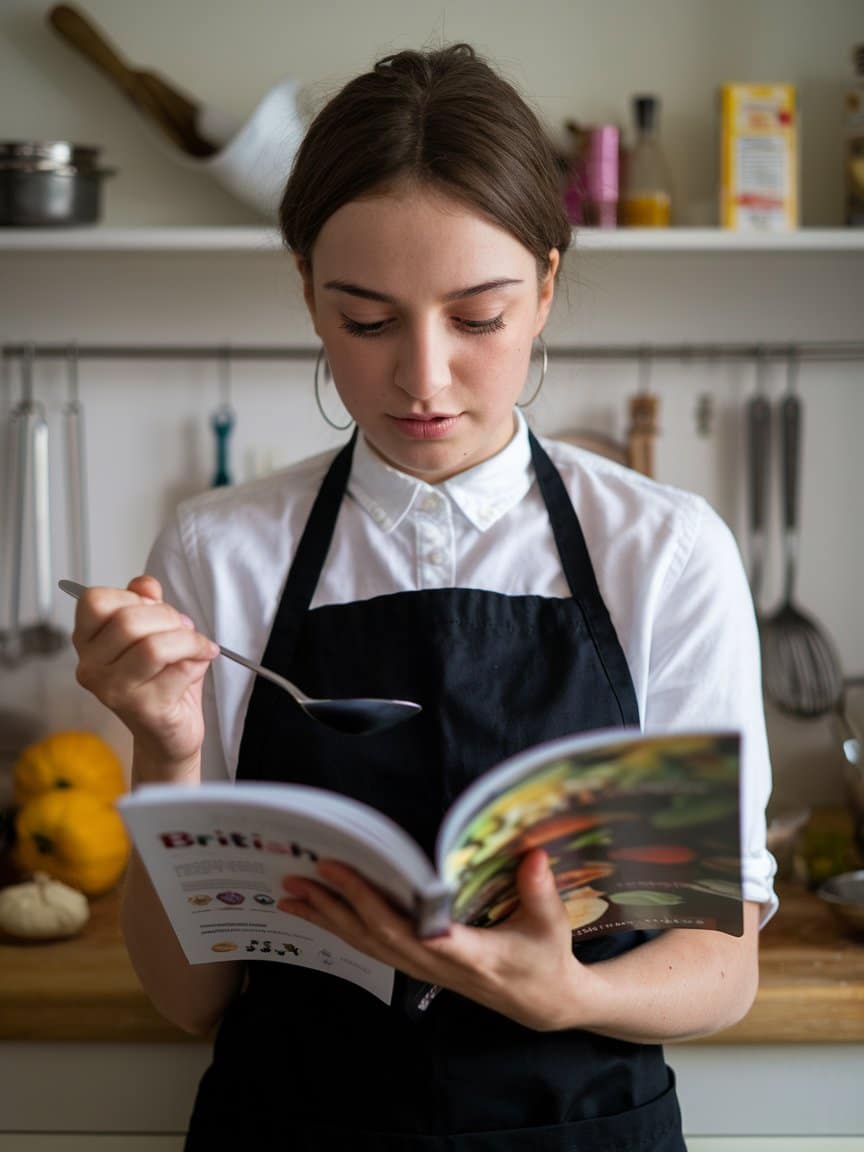
Veronica is a passionate food enthusiast with over three years of experience in exploring and writing about diverse cuisines. Her expertise lies in reviewing restaurants, sharing creative recipes, and discovering the latest food trends. As the voice behind FoodieRecap.com, Anju brings fresh perspectives and culinary insights to her audience.
